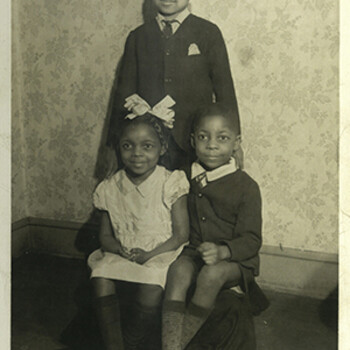Exhibit Honors Siblings George Bundy Smith ’62 and Inez Smith Reid ’62

A string of pearls, a weathered Bible, and an assortment of family photos paint a storied portrait of two distinguished Yale Law School alumni in “Twins on the Bench,” an exhibit now on view in the Lillian Goldman Law Library.
The exhibit offers an intimate look at the lives of George Bundy Smith ’62 and Inez Smith Reid ’62, twin siblings who were the only Black students in their class.
Born in New Orleans, Louisiana and raised in Washington, D.C., when the city was still segregated, both Smith and Smith Reid would end up serving as judges after pursuing different careers following law school.
Smith worked alongside Constance Baker Motley at the NAACP Legal Defense and Educational Fund, and served on the New York City Civil Court, New York State Supreme Court (as well as its Appellate Division), and as associate justice of the New York Court of Appeals, the state’s highest court.
Smith Reid spent the first decade of her career in education, teaching in the Democratic Republic of the Congo and later at other colleges including Barnard as a professor of political science. While teaching at Barnard College, she was deeply beloved by her students and had a profound impact on their lives.
“She was my favorite teacher in the whole wide world,” said Enola Aird ’79. “[She is] the teacher who had the greatest impact on my life, and the lives of so many other Barnard graduates.”

Following her career in education, she spent time in private practice and in prominent government positions, including as corporation counsel for the District of Columbia. In 1995, she was nominated to serve as an associate judge of the D.C. Court of Appeals, retiring in 2017. The exhibit includes a photo of Judge Smith swearing in his sister during her confirmation ceremony.
The idea for the exhibit came from Shana Jackson, who works in the Law Library and has familial ties to the late Judge Smith via marriage.
“I just wanted to make certain that they weren’t overlooked within the Law School’s history, and I felt as though a spotlight needed to be shined on them,” she said.
Jackson, who affectionately refers to Smith as “Uncle George,” first proposed a commemorative portrait of the twins in 2019. The portrait was unveiled on April 16, 2023 at the Law School and hangs in SLB Room 120.
To complement the portrait, Jackson worked with Law School Rare Book Librarian Kathryn James to co-curate a corresponding exhibit. The two started the curation process by compiling a collection of Smith’s belongings, a portion of which Jackson kept in her house after his passing, and from there James began researching the twins, their careers, and their family life to find other artifacts. With additional items donated by Alene Smith (Judge Smith’s widow) and Judge Smith Reid, Jackson and James were able to bring the exhibit to life.
James described learning about the twins through her research and in listening to Jackson’s history of the family.
“It was such an interesting, moving, and fascinating experience to learn about Judge Smith first, and then to realize this whole history that unfolded for me through working with Judge Smith’s collection in Manuscripts and Archives and with the family papers,” James said.
A core item in the exhibit is the initial study for the commemorative portrait, which was painted by artist Ashlynn Smith — the grandniece of the twins, and granddaughter of the twins’ older brother Sidney Smith Jr. — and based on a photograph of the three siblings in the family home. The original photograph can also be found in the exhibit.
As siblings with a lifetime of accomplishments as well as a deep commitment to family, it was important to Jackson and James that the exhibit honored the twins’ greatness in addition to showcasing their humanity. James found the familial items particularly moving, describing them as a “glimpse into the powerful family life of someone who was an important figure as an activist and as a judge.”
One item that James felt was important to include in the exhibit was a string of Reid’s “everyday pearls” (as Judge Reid described them, in a note included in the exhibit) that she wore everywhere, including to the grocery store.
“She discussed her pearls in an interview for an oral history, and they seemed such a powerful token of her conscious self-presentation,” said James. “Both judges knew that what they were doing was significant, and…they inhabited that role through their careers.”
Jackson intends to continue honoring the legacy of Reid and Smith, possibly with a documentary or by donating some of the exhibit material to the National Museum of African American History and Culture in Washington, D.C. She noted, “the exhibit only touches upon some things; it doesn’t nearly gather all that there is to be gathered.”
“Twins on the Bench” is on view on the second level of the Lillian Goldman Law Library through July 31.


